27 Oct 2020 - {{hitsCtrl.values.hits}}
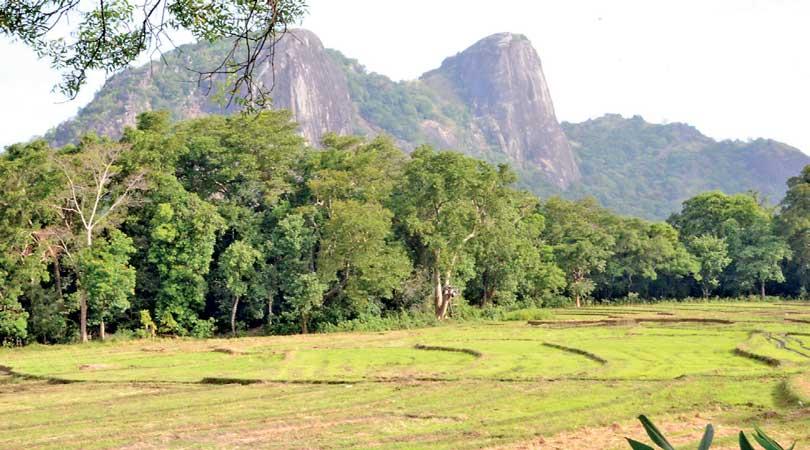
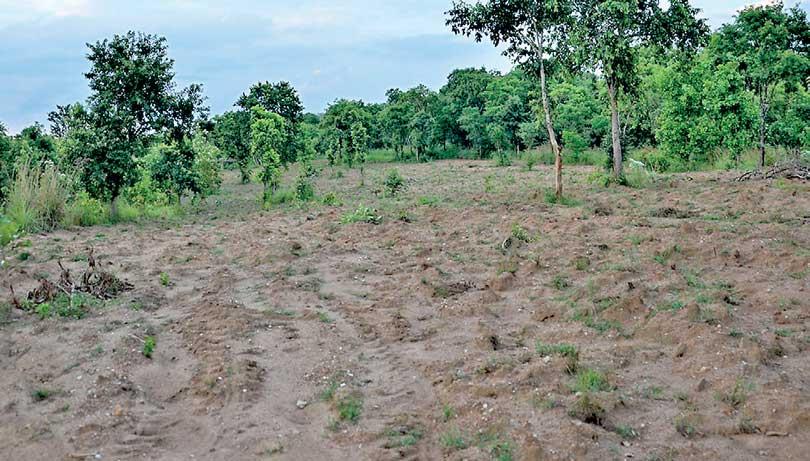
Nilgala Forest comes under the Department of Forest Conservation as well as the Department of Wildlife Conservation
 Nilgala Forest, which is one of the four ecological zones native to Sri Lanka, including Uva Pathanbima, has been subject to destruction on a large scale due to the cultivation of sorghum, members of the local communities in the area said.
Nilgala Forest, which is one of the four ecological zones native to Sri Lanka, including Uva Pathanbima, has been subject to destruction on a large scale due to the cultivation of sorghum, members of the local communities in the area said.
This destruction mainly takes place in Kotabova, Kalugahawadiya and Bendiyawa Grama Niladhari divisions belonging to Medagama Divisional Secretariat. As per our observations and based on information received from villagers, Grama Niladhari Officers and other sources, so far more than 2000 acres of forest land has been destroyed for the cultivation of sorghum.
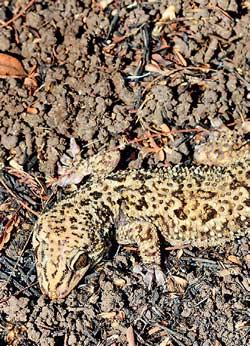 Bibila Nilgala, Rathugala, Bulupitiya, Pitakumbura, Karadugala, Galgamuwa, Nelliyadda, Hadagala, Atharagala, Perana, Peralanda, Thambana, Kotabova, Bendiyawa are some of the villages which surround Nilgala Forest.
Bibila Nilgala, Rathugala, Bulupitiya, Pitakumbura, Karadugala, Galgamuwa, Nelliyadda, Hadagala, Atharagala, Perana, Peralanda, Thambana, Kotabova, Bendiyawa are some of the villages which surround Nilgala Forest.
A resident of Kotabova, who spoke on terms of anonymity, said that Nilgala had been mostly destructed in Kotabova GN division. This destruction is carried out by outsiders and non-residents of the area. Even though there are 433 families living in the division, only 28 families live nearby the forest and each family has around 2 acres of land. However, outsiders including a Pradeshiya Sabha member of the area have illegally possessed around 25-30 acres of the forest. This PS member together with his supporters seized the forest lands gradually each year. We heard that this year they had seized 20-25 acres of land. There are more than 200 people who have illegally possessed forests land. I am disappointed with the failure of the Forest Department officers to protect the forest,” he added.
Nilgala Forest comes under the Department of Forest Conservation as well as the Department of Wildlife Conservation. The Eastern part of the forest belongs to the Department of Wildlife Conservation and spans 9000 hectares. A little more than 15000 hectares belong to the Forest Department. Nilgala Forest serves as a catchment area for Gal Oya; which is a water source of the Senanayaka Reservoir that supplies water to cultivations in the Eastern Province. This forest which receives rains during the northeast monsoon season, is a tropical dry mixed evergreen forest. The reason behind its destruction at present is the fact that this forest has not been gazetted as a Reserve yet.
Central Highlands, Knuckles Mountain Range, Sabaragamuwa and Rakwana Mountains and Uva Pathanbima are the four ecological zones native to Sri Lanka. Forests belonging to Uva Pathanbima are known as lowland Savannah and they are only native to Uva Province. Terminalia chebula, Terminalia belerica, Phyllanthus emblica, Pterocorpus marsupium are some of the prominent plant species found in this forest. This forest, which is covered in grasslands, is home to plants such as Heen Pengiri, Eth Thuttiri, Maha Pini Baru, Pini Baru, Eth Adi and Vishnukranthi.
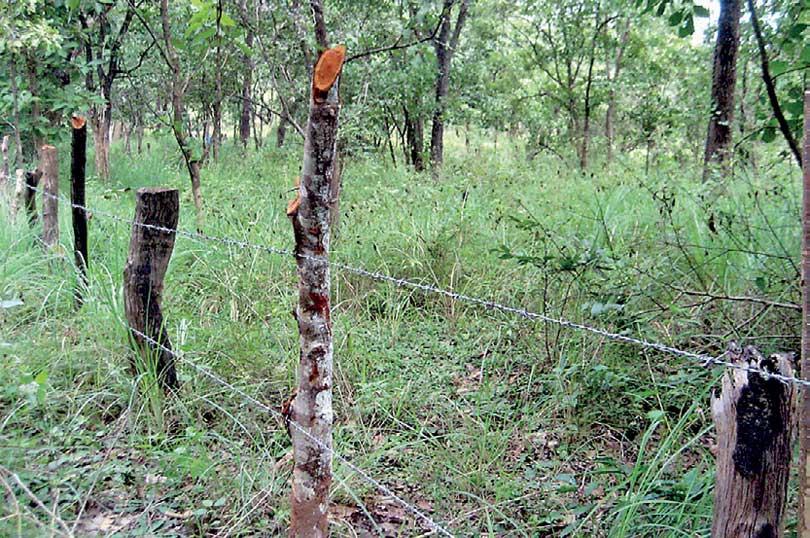
It is also home to several animal species which are unique to Uva Province such as two types of geckoes namely Ophisops leschenaultii lankae and Ophisops minor minor belonging to Lacertidae family. Both species are endemic to Sri Lanka.
There is also an amphibian species which is unique to this area known as Nannophrys naeyakei. This species of frog was discovered by Mendis Wickramasinghe in 2007.
The three species Perdicula asiatica ceylonensis, Francolinus pictus watsoni and Treron Phoenicopterus phillipsi which can be seen only in this forest and are endemic to Sri Lanka were named endangered by a Red Data List issued by the International Union for Conservation of Nature. In addition, Picus xanthopygaeus is a rare bird species found in Uva Pathanbima.
DAILY DESTRUCTION
A species of gecko which is endemic to Sri Lanka, known as Calodactylodes illingworthorum live under rocks surrounded by trees in Nilgala Forest. There are two species belonging to Calodactylodes family and the other species are found in India. This is an important bio fossil which explains the geographical relationship between Sri Lanka and India.
The gecko species known as Hemidactylus hunae is another rare animal species found in Nilgala. Another species of gecko endemic to Sri Lanka known as Dasia Helianus also live in this forest.
A species of caterpillar found in this forest known as Barronet ( Euthalia nais ) and feeds on Kutumberiya plants also serves as another factor which claims the significance of this forest.
N. Surasena, who is an Agricultural Research and Production Assistant in Kotabova Division, said that this forest has an extent biodiversity and is a catchment area for Rambakan Oya, Dahamal Oya, Thammadilla Oya, Dik Oya and Gal Oya. Senanayake Reservoir is protected only if this forest is protected. Unfortunately, there are few people who would think so. This forest is being destroyed by many people every day. “This time, fertilizer subsidies have been requested for 800 hectares. However only less than 20% of the lands have licenses. The rest of the lands are illegally possessed lands. They belonged to the forest, but people have been cultivating in them illegally. Several Chena cultivators claim that they have licenses. Yet, we do not understand how they received such licenses. Some claim that in 1996 former President Chandrika Kumaratunga released 250 acres of land for cultivation. Yet, none of them got a license. There are permanent buildings in those lands at present. Few officers of the Forest Department cannot protect this forest and they lack facilities. In order to ensure the protection of the forest, an STF camp should be established at the entrance to the forest. We made that suggestion to save the forest and yet we do not see any result. If that suggestion had been carried out earlier, this forest could have been protected,” said Surasena.
According to residents of Kotabova, people from areas such as Monarawana, Kalugahawadiya, Aratumadilla, Kongolla, Nannapurawa, Senpathigama, Aiwela and Bendiyawa have possessed lands in Nilgala Forest. They say that these people seize lands every year and sell them back for 0.2-0.3 million Rupees to various people.
K. M. Dharmasena, a resident of Narangolla, Kotabova said that Nilgala Forest is no more. People who live surrounding this forest have possessed lands illegally. “First, they cultivate the forest lands clearing only the bushes and later they start felling big trees and set fire to them. The forest area under the Department of Wildlife Conservation is the only area to have remained protected. The rest of the forest is so vulnerable. Even now, you will be able to see harvesting in forest lands, felling trees and mining sand illegally. It is true that Forest officers frequent those areas, yet there is no decrease in the destruction. After culverts were built across canals at the entrance to the forest, vehicles such as tractors could enter the forest and it increased the destruction,” he added.
H. A. Latheef, a farmer aged 54, who is a father of four children, is also a resident of Nannapurawa, Kotabova. He is engaged in illegal cultivation near the forest. This is what he shared with us.
In a discussion held between our subject Minister and MPs and officers of the district, it was decided to give approval for those who engaged in chena cultivation in lands under the purview of the Forest Department till 2009
Bharatha Disanayaka
“In 1996, President Chandrika allocated 250 acres of land extending from Dimbuldena streamlet. President Mahinda allocated another 250 acres. We do not destruct the forest. We acknowledge that some people destruct the forest by felling trees and later harvest the lands. Years ago, a group of monks visited the forest and blessed some trees.Yet even those trees have been cut. Whenever an issue occurs, Forest Officers only point fingers at our lands. ” he said.
Nilgala Forest is also home for a large number of wild elephants. Due to the destruction and segmentation of forests due to chena cultivation, elephant crossings become non apparent causing elephant-human conflict.
Raja Vidanapathirana of Monaragala Soba Padanama Organization said that many lands in Nilgala are often on fire and this is not caused naturally. The extent of forest area destroyed in that manner cannot be precisely calculated. However, it can be said that more than 3000 acres of forest lands are destroyed per year. People from surrounding areas are responsible for these fires. One of the reasons for this is to seize lands. According to paragraph 9 of the Fauna and Flora Protection Ordinance amended by the Fauna and Flora Act No 22 of 2009, in order to carry out any development project within a mile from the border of a national park, the written approval of the Wildlife Director General is required. However, several years ago a project to grow pineapple in 500 acres of this area was initiated after destroying the forest completely. In addition, according to the gazette notification No 7772/22 dated 24.06.1993 as per the National Environment Act (Amendment) No 47 of 1980, if a land of more than one hectare is cleared for a development project, it should be subject to an environmental impact assessment prior to its use for the project. However, in 1996 and in 2009, 250 acres of this forest has been distributed among public by the politicians ignoring the law. However, even this year the district development committee has given approval to these illegal landowners to cultivate on these lands. How can a forest be protected when such decisions are being taken? How can a Forest Officer perform his duties?
Many people have been complaining that Medagama Divisional Secretariat has issued license for forest lands under the purview of Forest Department. When inquired, the Divisonal Secretariat of Medagam, Kapila Bandara said that his office has never issued a license for any person cultivating or living in Nilgala Forest area.
“Nilgala is the heart of Uva and that place should certainly be protected,” he added.
Nilgala forest comes under the Department of Forest Conservation as well as the Department of Wildlife Conservation. Even though Wildlife officers have been able to protect the forest area under their control, the Forest officers have failed to protect the area under their purview. We made inquires from the District Forest Officer Bharatha Disanayaka.
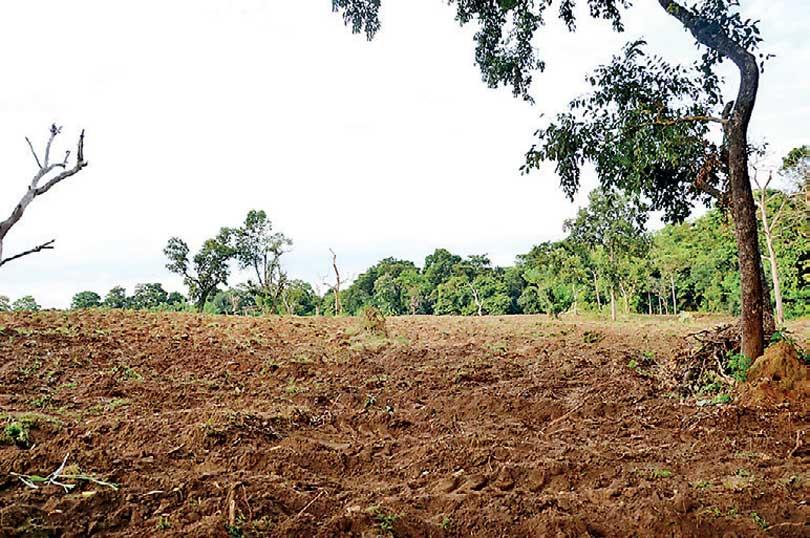
“The forest area under Department of Wildlife Conservation is mostly surrounded by the area under our control. That is the reason why our area is exposed to great risk. We have a limited number of officers. However, these criminals are very careful. Nilgala is a proposed reserve and we clearly indicated our boundaries. We will be taking legal actions against those who are within those boundaries soon,” said Disanayaka.
We also inquired from the District Forest Officer Disanayaka on the decision taken by the Monaragala district development committee to provide approval for those who have illegally possessed lands.
“In a discussion held between our subject Minister and MPs and officers of the district, it was decided to give approval for those who engaged in chena cultivation in lands under the purview of the Forest Department till 2009, to cultivate those lands only in this season. That approval will be given after a field visit,” he said.
27 Nov 2024 2 hours ago
27 Nov 2024 3 hours ago
27 Nov 2024 3 hours ago
27 Nov 2024 3 hours ago
27 Nov 2024 3 hours ago